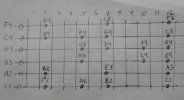This thread is related to my earlier thread https://sevenstring.org/threads/jus...al-guitar-by-restringing-and-retuning.335492/
A new thread has been started because the system is now using a superior minor thirds base tuning, and because i am presenting the system in a new simpler, more concise, but also more detailed way.
The earlier thread is verbose and messy, and contains variations of the system, so a new thread is needed to make a fresh start, create a focus on the new base tuning and improved presentation, and avoid confusion.
It is not necessary to read the earlier thread, i actually recommend you avoid the presentations of the system it contains until you understand the presentation in this thread.
I will very soon submit 2 posts in this thread with a document in each.
Then a 3rd post will contain the documents in useful image forms.
I ask forum members to please wait until all 3 posts are posted before adding your own posts, just to keep the presentation unbroken.
One document is for scales with mostly major intervals, the other is for scales with mostly minor intervals.
These 2 documents belong together as a pair, and will often be used together, for the reason explained in the documents.
However, each document is a complete presentation of the system.
At first, i recommend choosing and working through one document.
+14 cents and -14 cents are not the only pitch offsets that can be used, there are 3 more primary offsets that i might present in future, that allow playing the more tonally unusual 'septimal' and 'undecimal' Just Intonation intervals.
A new thread has been started because the system is now using a superior minor thirds base tuning, and because i am presenting the system in a new simpler, more concise, but also more detailed way.
The earlier thread is verbose and messy, and contains variations of the system, so a new thread is needed to make a fresh start, create a focus on the new base tuning and improved presentation, and avoid confusion.
It is not necessary to read the earlier thread, i actually recommend you avoid the presentations of the system it contains until you understand the presentation in this thread.
I will very soon submit 2 posts in this thread with a document in each.
Then a 3rd post will contain the documents in useful image forms.
I ask forum members to please wait until all 3 posts are posted before adding your own posts, just to keep the presentation unbroken.
One document is for scales with mostly major intervals, the other is for scales with mostly minor intervals.
These 2 documents belong together as a pair, and will often be used together, for the reason explained in the documents.
However, each document is a complete presentation of the system.
At first, i recommend choosing and working through one document.
+14 cents and -14 cents are not the only pitch offsets that can be used, there are 3 more primary offsets that i might present in future, that allow playing the more tonally unusual 'septimal' and 'undecimal' Just Intonation intervals.












 The original thread is a mess and does not present the system particularly well.
The original thread is a mess and does not present the system particularly well.